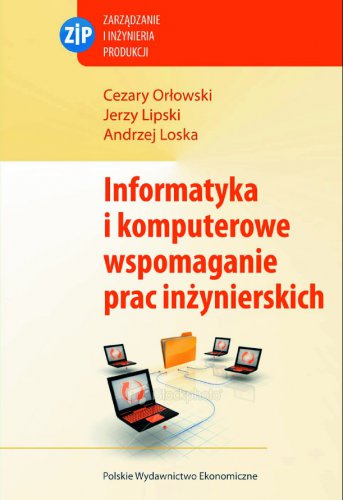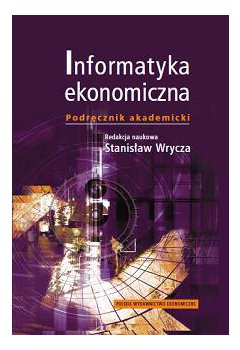Informatyka i komputerowe wspomaganie prac inżynierskich
Publication date: 2012
Place publication: Warszawa
Publication: I
Binding: paperback
Format: B5
The aim of the book is to present the architectures and resources of IT systems and methods of their application by engineers who deal with production engineering. It contains description of the tools and environment of development of information technology systems, and defines the areas of computer-aided support to engineering work. Also presented are model solutions and practical use made of information technology applications to support the development of such technological systems as CAD, CAMD material designing, CAM manufacturing processes and performance of maintenance-related tasks. In their book the Authors contained many examples of most popular systems of supporting of CAE engineering work. Control questions included in the manual make it easier to consolidate the knowledge acquired.
The book is intended for students of the courses in production management and engineering in universities of technology.
Spis treści
Wstęp
Rozdział 1. Struktury systemów informatycznych
1.1. Zasoby systemów informatycznych
1.1.1. Bazy danych i ich charakterystyka
1.1.2. Modele baz danych
1.1.3. Bazy wiedzy i ich charakterystyka
1.1.4. Bazy multimedialne
1.2. Architektury systemów informatycznych
1.2.1. Wprowadzenie
1.2.2. Architektury zorientowane obiektowo
1.2.3. Architektury funkcjonalne i sprzętowe
1.2.4. Architektury klienta i dostawcy
1.2.5. Architektury sieciowe
1.2.6. Potrzeba integracji architektur systemów informatycznych
1.3. Podstawy przetwarzania zasobów informatycznych
1.3.1. Przetwarzanie algorytmiczne
1.3.2. Wykorzystanie logiki rozmytej w przetwarzaniu zasobów
1.3.3. Sieci neuronowe i ich zastosowanie
1.3.4. Wykorzystanie algorytmów ewolucyjnych
1.3.5. Systemy ekspertowe
1.4. Środowiska wytwarzania systemów informatycznych
1.4.1. Narzędzia CASE
1.4.2. Obiektowe środowisko wytwarzania .NET
1.4.3. Obiektowe środowisko wytwarzania J2EE
1.4.4. Obiektowe i strukturalne środowiska przeznaczone do wytwarzania małych systemów
1.4.5. Obiektowe i strukturalne środowiska przeznaczone do wytwarzania średnich i dużych systemów
1.4.6. Środowiska wytwarzania baz danych na licencjach GPL lub podobnych
1.5. Zadania i pytania kontrolne
Rozdział 2. Modelowe rozwiązania wspomagania prac inżynierskich
2.1. Charakterystyka głównych obszarów wspomagania prac inżynierskich
2.2. Wspomaganie projektowania i konstruowania systemów technicznych
2.2.1. Modelowy opis metod i technik wspomagania projektowania
2.2.2. Zasoby systemów informatycznych wspomagających prace inżynierskie
2.2.3. Architektura klienta do informatycznego wspomagania pracy inżyniera
2.3. Wspomaganie wytwarzania w systemach technologicznych
2.3.1. Modelowy opis metod i technik wspomagania informatycznego procesów wytwarzania
2.3.2. Zasoby systemów wspomagających projektowanie technologii
2.3.3. Architektura klienta w zakresie wspomagania informatycznego procesów wytwarzania
2.4. Modele wspomagania projektowania materiałowego CAMD
2.4.1. Modele projektowania materiałowego
2.4.2. Przykłady modeli materiałowych stosowanych w systemach CAMD
2.5. Komputerowe wspomaganie badań w technice
2.5.1. Modele zespołowych badań naukowych
2.5.2. Modele oceny zespołów realizujących badania naukowe
2.5.3. Problemy planowania procesów badawczych
2.5.4. Ocena przydatności metod i modeli komputerowego wspomagania badań w technice
2.5.5. Podsumowanie
2.6. Wspomaganie eksploatacji systemów technicznych
2.6.1. Informacja eksploatacyjna w systemie technicznym
2.6.2. Klasyfikacja i charakterystyka zasobów informacyjnych systemów wspomagania eksploatacji
2.6.3. Modelowy opis metod i technik wspomagania eksploatacji systemów technicznych
2.6.4. Zarządzanie zasobami
2.7. Zadania i pytania kontrolne
Rozdział 3. Systemy informatyczne wspomagające prace inżynierskie
3.1. Systemy CAD i ich architektura
3.1.1. AutoCAD — wersje i funkcjonalność
3.1.2. System wspomagania projektowania Solid Edge
3.1.3. System CAD SketchUp
3.2. Systemy CAM i ich architektura
3.2.1. Podstawowe funkcje systemów CAM
3.2.2. System NX CAM jako narzędzie inżyniera technologa
3.3. Systemy CAMD i ich architektura
3.3.1. Klasyfikacja systemów CAMD
3.3.2. Przykłady systemów CAMD
3.3.3. Ocena funkcjonalna i użytkowa systemów CAMD
3.4. Systemy wspomagające badania w technice
3.4.1. Narzędzia i aplikacje informatyczne wspomagające organizację badań naukowych
3.4.2. Narzędzia i aplikacje informatyczne wspomagające techniczno-technologiczne aspekty badań naukowych
3.5. Systemy CMMs/EAM i ich architektura
3.5.1. Klasyfikacja i charakterystyka narzędzi wspomagających w obszarze eksploatacji
3.5.2. Modelowy opis najważniejszych cech i funkcji systemów klasy CMMs/EAM
3.5.3. Przykłady narzędzi klasy CMMs/EAM
3.5.4. Wdrażanie i sposób organizacji informacji dla potrzeb systemów klasy CMMs/EAM
3.5.5. Przykład wspomagania zadań eksploatacyjnych z wykorzystaniem systemu klasy CMMs/EAM i systemu ekspertowego
3.6. Zadania i pytania kontrolne
Bibliografia
Indeks
| Odbiór osobisty | 0 € |
| Inpost Paczkomaty | 4 € |
| Kurier Inpost | 4 € |
| Kurier FedEX | 4 € |
| Free delivery in Reader's Club | from 47 € |
Informatyka ekonomiczna. Podręcznik akademicki
Publication date: 2010
Place publication: Warszawa
Publication: I
Binding: hard cover


